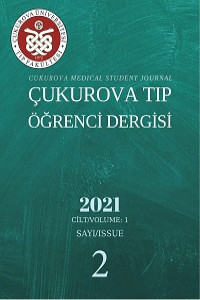Abstract
c
response to a random change in the presented auditory
stimulus that exceeds a certain limit and corresponds to a
noticeable behavioral discrimination threshold. Mismatch
Negativity, which emerged thanks to the oddball paradigm,
is acquered in the functions of the brain that do not require
attention. Although it is preferred in many areas in terms
of clinical use, its most common use for schizophrenia.
The aim of this review is to have information about
possible Mismatch Negativity findings in schizophrenia by
recognizing the Mismatch Negativity test and
schizophrenia, which is closely related to public health.
Mismatch negativity (uyumsuzluk negatifliği) beynimizin,
sunulan işitsel uyaranda belli bir sınırı aşan ve fark edilebilir
davranışsal ayırt etme eşiğine karşılık gelen random bir
değişikliğe otomatik cevap oluşturması ile üretilir. Oddball
paradigması sonucu meydana gelen mismatch negativity
beynin dikkate ihtiyaç duymayan faaliyetlerinde elde
edilmektedir. Klinik kullanımı açısından birçok alanda
tercih edilmekle beraber en yaygın kullanımı şizofreni
seyrinde olmaktadır. Bu derleme de amaç mismatch
negativity testini ve toplum sağlığını yakından ilgilendiren
şizofreniyi tanıyarak şizofrenide olası Mismatch Negativity
bulguları hakkında bilgi sahibi olmaktır.
References
- 1. Arslan S, İskender Z. İşitsel kortikal cevaplar: özellikler ve klinik uygulamalar. Türkiye Klinikleri Kulak Burun Boğaz - Özel Konular. 2015;8(2):48-53.
- 2. Uluskar G. Çoklu özellik dizisi mismatch negativity: test-tekrar test güvenilirlik çalışması (Yüksek Lisans Tezi). Ankara, Hacettepe Üniversitesi, 2013
- 3. Hall J. P300 response and mismatch negativity (MMN) response. In eHandbook of Auditory Evoked Responses (Ed M Hall): 716-823. 2015.
- 4. Katz J. Handbook of Clinical Audiology. A Wolters Kluwer Company, 2002;235-253.
- 5. Näätänen R, Paavilainen P, Rinne T, Alho K. The mismatch negativity (MMN) in basic research of central auditory processing: A review. ClinNeurophysiol. 2007;118:2544-90.
- 6. Näätänen R, Tervaniemi M, Sussman E, Paavilainen P, Winkler I. Primitive intelligence in the auditory cortex. Trends Neurosci. 2001;24:283-8.
- 7. Näätänen R, Paavilainen P, Tiitinen H, Jiang D, Alho K. Attention and mismatch negativity. Psychophysiology. 1993;30:436-450.
- 8. Rinne T, Alho K, Ilmoniemi J, Virtanen J, Näätänen R. Separate time behaviors of the temporal and frontal mismatch negativity sources. Neuroimage. 2000;12:14-19.
Abstract
Mismatch Negativity is produced by our brain's automatic
response to a random change in the presented auditory
stimulus that exceeds a certain limit and corresponds to a
noticeable behavioral discrimination threshold. Mismatch
Negativity, which emerged thanks to the oddball paradigm,
is acquered in the functions of the brain that do not require
attention. Although it is preferred in many areas in terms
of clinical use, its most common use for schizophrenia.
The aim of this review is to have information about
possible Mismatch Negativity findings in schizophrenia by
recognizing the Mismatch Negativity test and
schizophrenia, which is closely related to public health.
References
- 1. Arslan S, İskender Z. İşitsel kortikal cevaplar: özellikler ve klinik uygulamalar. Türkiye Klinikleri Kulak Burun Boğaz - Özel Konular. 2015;8(2):48-53.
- 2. Uluskar G. Çoklu özellik dizisi mismatch negativity: test-tekrar test güvenilirlik çalışması (Yüksek Lisans Tezi). Ankara, Hacettepe Üniversitesi, 2013
- 3. Hall J. P300 response and mismatch negativity (MMN) response. In eHandbook of Auditory Evoked Responses (Ed M Hall): 716-823. 2015.
- 4. Katz J. Handbook of Clinical Audiology. A Wolters Kluwer Company, 2002;235-253.
- 5. Näätänen R, Paavilainen P, Rinne T, Alho K. The mismatch negativity (MMN) in basic research of central auditory processing: A review. ClinNeurophysiol. 2007;118:2544-90.
- 6. Näätänen R, Tervaniemi M, Sussman E, Paavilainen P, Winkler I. Primitive intelligence in the auditory cortex. Trends Neurosci. 2001;24:283-8.
- 7. Näätänen R, Paavilainen P, Tiitinen H, Jiang D, Alho K. Attention and mismatch negativity. Psychophysiology. 1993;30:436-450.
- 8. Rinne T, Alho K, Ilmoniemi J, Virtanen J, Näätänen R. Separate time behaviors of the temporal and frontal mismatch negativity sources. Neuroimage. 2000;12:14-19.
Details
| Primary Language | Turkish |
|---|---|
| Subjects | Clinical Sciences |
| Journal Section | Review |
| Authors | |
| Publication Date | December 30, 2021 |
| Published in Issue | Year 2021 Volume: 1 Issue: 2 |


